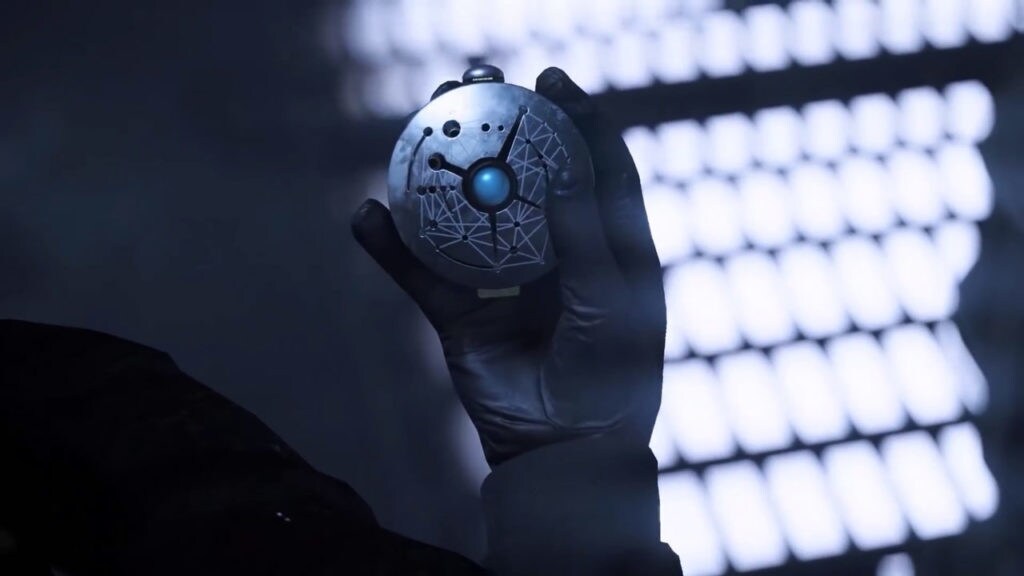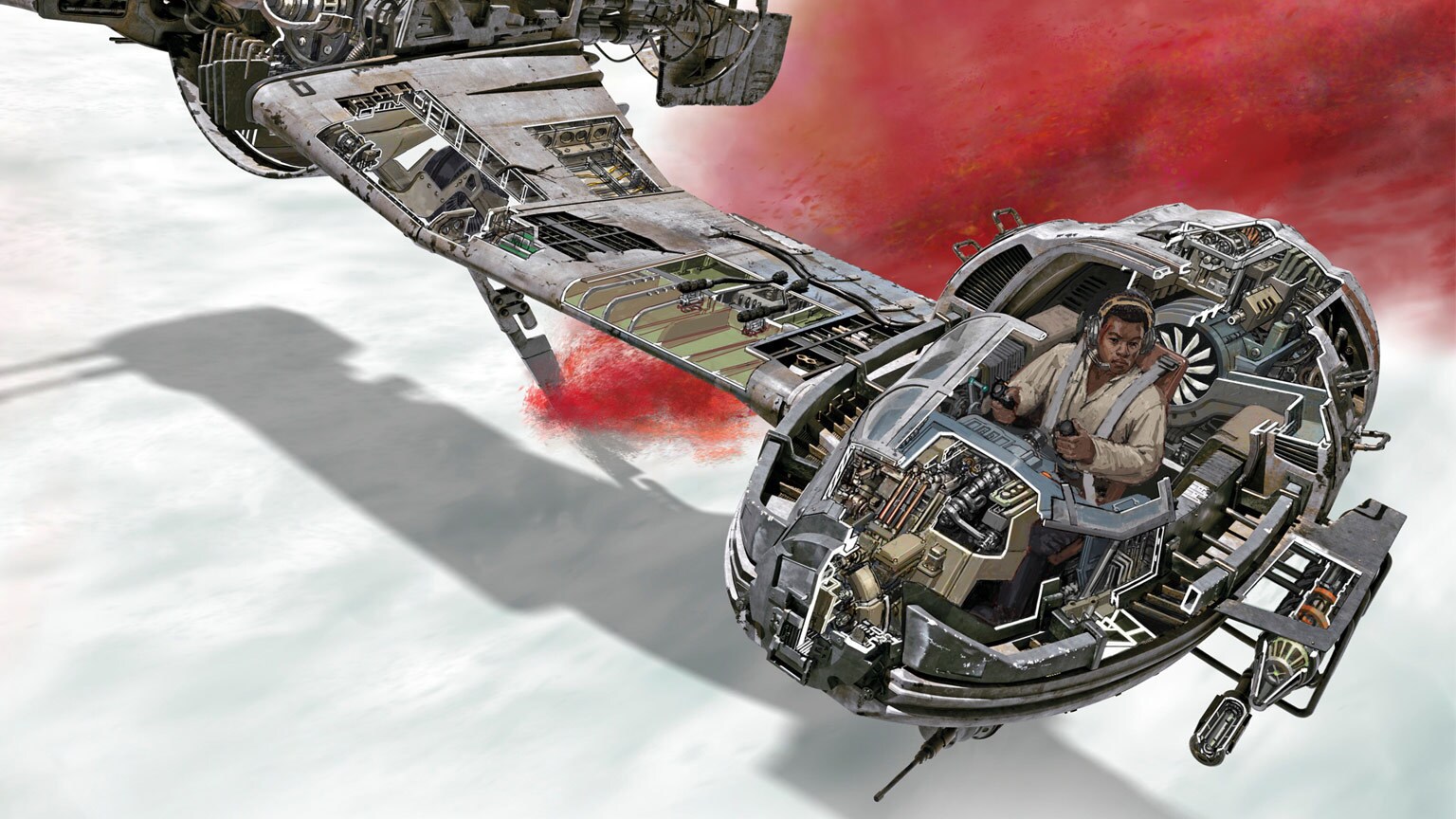Even after multiple viewings, Star Wars: The Last Jedi is a trove of sights to discover, revealing more hints of a larger universe -- and thankfully, it arrives on Digital and via Movies Anywhere tomorrow, and on 4K Ultra HD, Blu-ray, and On-Demand on March 27.
But what better way to learn more about the characters, places, and things of the galaxy seen in The Last Jedi than to learn from our own equivalent to a holocron on the subject, the Star Wars: The Last Jedi - The Visual Dictionary from DK Publishing. Written by Pablo Hidalgo, whose role on the Lucasfilm Story Group ensures he’s in the know for everything happening in the Star Wars universe, the Visual Dictionary literally defines what we see in the film by providing names and filling in the details that take us beyond the movie. Here’s some of the coolest tidbits of knowledge we learned from this comprehensive guide, along with some select interior spreads.
1. Med ship, gun ship, two ships, one ship.
We know from The Last Jedi that Vice Admiral Holdo is the commander of the Ninka before her promotion to lead the entire Resistance fleet, but which one is the Ninka? And what are the names of the other ships? The Visual Dictionary has us covered -- General Leia Organa’s Mon Calamari flagship is named after none other than the rebel admiral who backed up Jyn Erso’s mission to Scarif, Rogue One's Admiral Raddus (seen in the image above). The Raddus is heavily automated and can project its deflector shield far from its hull, allowing it to defend smaller ships within range. Though he had clashed with its namesake, Admiral Ackbar was the one to petition the naming of the ship after his fellow Mon Calamari hero. During the evacuation, the cargo frigate Vigil was commanded by Vice Admiral Jotis, while Vice Admiral Resdox is given command of the Anodyne, which was a decommissioned New Republic Nebulon-C escort frigate converted to a hospital ship. As for the Ninka, it’s no slouch -- this small Corellian cruiser packs a lot of weaponry, including heavy plasma bombs used in orbital strikes.
2. Island living.
While it was difficult for the Resistance to find a map to Luke Skywalker, readers of this reference have it easy: there’s a map of the island on Ahch-To that is home to the origins of the Jedi. In addition to the Jedi Temple, and Jedi Village, where Rey and Luke stay, there’s also the mirror cave, and a separate village that is home for the Caretakers, the female Lanais who maintain the Jedi structures out of a sworn duty. More detail is given about the Lanais, whose males, known as the Visitors, spend most of their time at sea as fishermen, coming to the island monthly with their catch. The sentient Lanais are distantly related to the unintelligent but very curious porgs. And the library of ancient books Luke has collected are stored in the hollow of timeworn Force-sensitive uneti tree.
3. Fellowship of the rings.
The Visual Dictionary series excels at taking readers beyond the film by filling out the galaxy with extra details that provoke even more questions: everyday items tell their own stories. While Rose’s medallion and Rebel Alliance ring are featured in the plot of the film, other characters have rings and other items of jewelry that lend their own stories. Poe Dameron wears a ring on a necklace -- it was his mother’s wedding ring, made from a steel washer from some old Rebellion machinery. Supreme Leader Snoke also had a ring -- capped with a piece of obsidian from the catacombs below Darth Vader’s castle on Mustafar. Amilyn Holdo’s accessories represent the astronomy from her homeworld of Gatalenta: the multiple rings on her tiara represent her world’s multiple suns, while her bracelets outline Gatalentan constellations. Even Luke Skywalker carries a piece that surely has a tale behind it -- he keeps a bolo with a recovered Jedi Crusader pendant, carrying a trophy piece of a broken Sith lightsaber crystal.
4. Executing orders.
Aboard the Supremacy, Finn and Rose find that they’ve really stuck their necks out for the Resistance when the First Order looks like they’re going to come out ahead. But who are those mysterious executioner troopers and why does the First Order resort to such theatrics for dispensing justice? I’m glad you axed!
In a section on stormtroopers, we learn that public executions are part of the First Order’s way of clamping down on disloyalty. Instead of being a special unit assigned to a head honcho, any stormtrooper may be assigned to executioner duty for a day, and then will suit up in special executioner armor with black shoulder armor and the distinctive helmet with the black stripe over their right eye. The ability to execute even their fellow First Order members without wavering shows they’ve got the chops as an effective stormtrooper. While on regular duty, stormtroopers have their serial number broadcast from their helmets to other nearby helmet displays, but executioner helmets keep the axe-wielders anonymous from their peers, but not to their commanders. Each laser ax opens with two sets of emitter claws on each side that create razor-sharp monomolecular energy ribbons. Detachment is the aim of this detachment!
5. Wordly wise.
Ever watch a movie or TV show on your own and pause your viewing to read something written in the film, whether it is a character’s to-do list, a message on a blackboard, newspaper headline, or newsfeed ticker? In Star Wars, there’s that added bonus of having to translate it from Aurebesh! Here’s a few of the key words and phrases seen on items and places in The Last Jedi.
One of the easier ones to translate (or even guess) is on the helmets of the law enforcement in the casino city: CBPD -- for Canto Bight Police Department. One fun fact about those helmets is that the department letters can also be holographically projected in reverse so they can be read in a rearview mirror! On the other end of the legal spectrum, the con artist and codebreaker known as DJ has his own motto stamped on his head: the Aurebesh on a metal plate on his hat translates to “Don’t Join”, the source of his nickname, and his main philosophy that no matter the larger cause, they’ll just grind you up. Two of the proton bombs from MG-100 StarFortress heavy bombers have some hand-written messages from the ordnance crew: “Hi Snoke” and “Han says Hi”. Rose Tico’s borrowed First Order major’s uniform has the name Tarkin sewn on the left armband. If reading Aurebesh is too easy, the Lanais have their own cuneiform writing system based on the shapes of their bird feet -- there’s a clay chopping board to decipher! And speaking of words, the Visual Dictionary confirms that Poe deliberately refers to Hux as “General Hugs” in an attempt to infuriate the pasty general.
6. Last line of defense.
While Supreme Leader Snoke still has a mysterious background, many details about his Praetorian Guard are revealed. Shunning ranged weaponry, these four pairs of warriors protect the Supreme Leader from anyone afforded an audience with their reclusive boss. While their red armor link back to Emperor Palpatine’s brilliant red Royal Guard, their armor and weapons reveal their lethality. Their segmented armor is powered, able to create a localized magnetic field that helps deflect blaster fire and even glance off indirect lightsaber blows. The weapons of the guard, while based on more ancient hand weapons, are fitted with ultrasonic generators to create high-frequency vibrations across the cutting edge, while placed in front of each blade is an electro-plasma filament that generates an energy blade capable of parrying lightsabers. Their weapons include the Bilari electro-chain whip, twin vibro-arbir blades that can be connected or separated, a vibro-voulge, and an electro-bisento. While the origins of the Praetorians remain a mystery, their name stems back to the 14th Atrisian Emperor of Kitel Phard.
7. Connections to other tales!
The Force binds everything together, and the Visual Dictionary follows suit, homing in on little details that help connect other Star Wars stories to The Last Jedi, from books to video games. In a spread about Luke’s life on Ahch-To, we learn that he learned how to spearfish from great heights during his time on Lew’el, which is covered, from a certain point of view, in The Legends of Luke Skywalker by Ken Liu. Also picked up in his travels is Luke’s star compass, reclaimed from one of Palpatine’s observatories on Pillio, as seen in a mission in Star Wars Battlefront II. The Visual Dictionary helps to identify many of the Cantonica denizens featured in the Canto Bight anthology from Del Rey, including the mysterious Grammus sisters, the impossibly lucky Winning Three, Masseur Lexo Sooger and contest winner Kedpin Shoklop. Phasma gets a double dose of references: her spread bring up her background on the merciless world of Parnassos, chronicled in the novel Phasma by Delilah S. Dawson, as well as her escape from Starkiller Base and the cover up of her treason, as detailed in the Marvel comic Captain Phasma by writer Kelly Thompson and artist Marco Checchetto. Rose and Paige Tico’s descriptions connect directly with their stories told in Cobalt Squadron by Elizabeth Wein, and Bomber Command by Jason Fry, while the spreads for Vice Admiral Holdo and the abandoned Rebel base at Crait tie back to Leia, Princess of Alderaan by Claudia Gray. And remember that uneti tree that Luke keeps the Jedi library in? It’s the same type of Force-sensitive tree as seen in the Jedi Temple on Coruscant in The Clone Wars animated series, which survived in two saplings, as shown in the Shattered Empire comic by Greg Rucka.
8. Canto Bites?
The creatures of The Last Jedi get fleshed out in the sections about their environments, and we learn some interesting facts about many of them. The crystalline vulptex is well suited for the dark mines of Crait. With their keen eyes that work well in low light conditions, long bushy whiskers that can help them navigate in the dark, it’s no wonder that a skulk of vulptices has moved into the abandoned mines. Fathiers, the racing beasts of Canto Bight, stand 3 meters high at the shoulder, which means that a jockey’s fall is often fatal. While the racing fathiers are bred for speed and endurance, and can reach speeds up to 75 kilometers per hour, they can’t maintain full speed for long distances, causing their riders to apply force to get key bursts of speed. Their wing-like ears help act as rudders for steering through air as well as shed excess body heat through a high concentration of blood vessels near the ear surface. Sadly, fathier pens are so small that the animals must sleep standing, which causes them to be constantly tired and easily irritated. The porgs of Ahch-To, on the other hand, have plenty of space to roam and nest. Their dense feathers and down help insulate their bodies while their large eyes provide stereoscopic vision for spotting fish to eat. While their webbed feet are ideal for swimming, the dry and crunchy legs of a rotisserie porg are the ideal part for eating, according to Chewbacca.
Star Wars: The Last Jedi - The Visual Dictionary is available now.
Star Wars: The Last Jedi arrives on Digital and via Movies Anywhere on March 13, and on 4K Ultra HD, Blu-ray, and On-Demand on March 27.
James Floyd is a writer, photographer, and organizer of puzzle adventures. He’s a bit tall for a Jawa. You can follow him on Twitter at @jamesjawa or check out his articles on Club Jade and Big Shiny Robot.

















